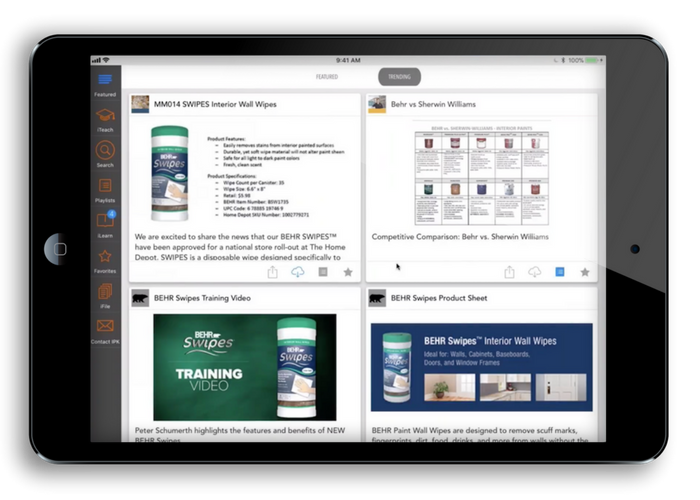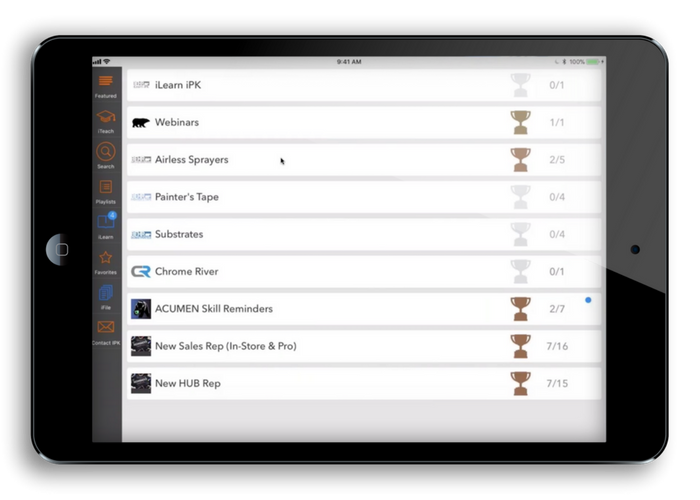The Behr Paint Company is one of the most visible paint and stain brands in the market. The company boasts $2 billion in sales per year and is sold in Home Depot locations across North and Central America. Behr’s sales training and development (T&D) team serves different customers—ranging from the 10,000 Home Depot, Ace Hardware, and Target paint associates to the 700 Behr sales representatives who train these associates.
The Challenge: Limited Resource Delivery & Analytics
Behr's T&D team needed a more efficient system for not only delivering resources for their sales team, but also for measuring the effectiveness of those resources. Because the sales team usually received training resources via email, their options for accessing content were limited. And, as a result, the T&D team had minimal reporting and analysis on the usage of these resources.
To prevent these issues, the T&D team needed:
- A flexible resource delivery system that could accommodate a field sales team spread across the country. This required a system that's decentralized enough to accommodate the diverse sales force, and is flexible enough to easily organize digital content.
- An affordable system that could both input and output data and integrate with existing systems.
- A platform that can provide analysis in more detail—and, as a result, insights in more detail—about the content they are pushing out to the sales team.
The Approach: Replace and repurpose
Brian and the T&D team investigated other resources within Behr that they could leverage or repurpose to help address these challenges. During this process, they discovered that another department at Behr had created an app to showcase customer testimonials.
That campaign, however, had taken a different direction and the app was never used. After a meeting with IT, Brian and his department soon had a revamped version of the abandoned app that could be used for training.
When the app was first rolled out, it only contained training videos, which the sales team mainly accessed with their iPhones in the field (Behr’s sales reps spend roughly 95% of their time in retail locations).
Google Analytics revealed videos were being watched, used, and shown several times. The sales reps’ overwhelming feedback to management explained that, while they enjoyed using electronic devices for training compared to computers, their iPhones weren’t advanced enough for in-field needs. As a result, their computers were soon replaced with iPads.
The positive feedback and increased usage of the training resources led to leadership approval to upgrade the app to support more content and features.
The Solution: Introducing xAPI into the iPK App
The final version of the app is called iPK (PK stands for Product Knowledge) and has two main goals:
- Provide quick and easy access for in-field sales reps.
- House various forms of content—such as PDFs, video, native HTML5 (Captivate) files, and a web browser that can connect to content outside the app.
xAPI for access
iPK is outfitted to use xAPI to track learners and how they access the app (e.g., direct sign-in, push notification, email links) and if the methods of accessing the app differ based on the content that's viewed. This helps Behr determine how to provide different types of content to ensure high levels of interaction.
xAPI for trending content
iPK also features a trending dashboard that shows the most-accessed training content from the last 30 days. The dashboard is powered using xAPI (or Experience API) content interactions—such as most downloaded, shared, viewed, playlisted, and more. In addition to being a helpful guide for sales reps, the dashboard provides the T&D team with insights into what content is accessed during specific campaigns.
For example, Behr’s latest product, Swipes, is featured prominently in the trending section. Additionally, competitive comparison charts show up frequently, which means the sales reps find this type of information useful. The appearance of this content in the trending section also shows the sales reps and associates are following the direction set forth by leadership. (See Images 1 and 2.)
xAPI for identifying gaps
To enhance user experience, Behr organized the content on the iPK app into three main categories.
- iTeach houses content that’s targeted to Home Depot associates and the end consumer. There are more than 600 pieces of content, which mostly consist of instructional video that can be filtered with keywords within iTeach. There’s also a scanning feature that can scan products and find related training content in the app. Because xAPI data shows what training content being searched and scanned most often, Behr’s T&D team can identify any essential content that’s missing or needs updating within the app.
- iFile contains anything that isn’t consumer facing—such as marketing memos, consumer report articles, and sales presentations.
- iLearn is mostly geared toward sales reps and contains materials about Behr products. The T&D team uses xAPI to learn what content reps have used or watched so the team can reward and recognize reps who actively use and engage with training content. (See Image 3.)
What's Next for Behr & xAPI?
A checklist will soon be featured on the iPK app, which will lend a hand in onboarding new hires in Behr’s business ventures and provide required product knowledge and soft skills training.



